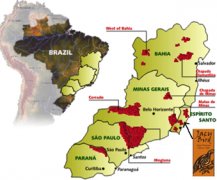Ethiopian coffee
Map of coffee producing areas in Ethiopia (source: Google)
Ethiopia is the hometown of Arabica coffee, and it is in the forests of Kaffa that you can see wild Arabica coffee. In Ethiopian, coffee is called "Bun" or "Buna". Coffee beans (coffee bean) may be translated from "Kaffa Bun". Arabica coffee has long been found in the Harald area, probably from the Kafa forest.
Essel coffee is processed by two processing methods: sun and water washing. The flavor of coffee processed by different processing methods is very different. Generally speaking, the alcohol thickness and soil taste of washed Sidamo, Yirgacheffe and Limmu coffee are slightly lower, and the taste of sun-processed coffee is more wild. But Essex coffee may taste different from batch to batch, which requires more cup tests in order to find really good coffee.
With regard to the grade of Ethiopian coffee: the highest grade of Ethiopian coffee Yega Xuefei and Yirgacheffe and Sidamo may be level 2 or 3 (G2 or G3), and most of the sun-processed coffee in eastern Ethiopia is grade 4 or 5 (G4, G5). In many cases, level 4 coffee is marked as level 5 in order to reduce taxes. At present, the grading is not uniform and messy, because there are also first-and second-tier (Grand G2) Yega Xuefei Coffee (Yirga Cheffe) processed by sun processing, but the highest grade of Harald (Harar) is Grade 4 (G4) (data: sweetmaria).
The coffee producing areas of Ethiopia are Hidamo, Harald and Sidamo, Harrar and Yirgacheffe. Sidamo and Harrar are provincial divisions, Sidamo is located in the south of Ethiopia bordering Kenya, and Harrar borders Somalia in the east of Ethiopia. Although Yirgacheffe is a community in the Sidamo region, its coffee is considered to be the best in Ethiopia because of soil composition and water content.
In the West, Ethiopian coffee is generally sold on the market as Yega Xuefei, Hidamo and Harald (Yirgacheffee, Sidamo and Harrar). In the field of boutique coffee, there are five other small places of coffee, namely, Lim, Jima, Le Campdi, Becca and Limmu, Djimmah, Lekempti, Bebeka and Wolega. The most common is Essehidamo or Harald coffee (Either Sidamo or Harrar coffee).
Harald Coffee (Harrar Coffee) comes from the eastern highlands of Ethiopia, with medium bean size, green yellow, medium acidity, full alcohol thickness and typical mocha flavor (mocha flavor). It is one of the most famous coffee in the world.
Wollega (Nekempte) coffee comes from the west of Ethiopia, with medium to large beans and is famous for its fruity flavor. The color is green and brown (greenish, brownish color), and the acidity and alcohol thickness are good. Can be made to match, can also be individual products.
Limu Coffee coffee is famous for its aroma and wine taste (spicy and Winnie flavor) and is very popular in Europe and the United States. The acidity and alcohol thickness are good, and the water-washed lim coffee is also the favorite of fine coffee. The bean shape is medium, greenish blue, mostly round.
Sidama Coffee coffee has medium bean shape and green gray. Hidamo washed coffee is known as sweet coffee (sweet coffee) with balanced taste and flavor. It has fine acidity and good alcohol thickness. It is produced in the south of Ethiopia and can be mixed with boutique products.
Yirgacheffe Coffee has a strong floral flavor. Washed Yega Chuefei is one of the best high-estate coffee in the world with soft acidity and rich thickness. Tepi and Bebeka coffee, with low acidity but high alcohol thickness, are indispensable members of blended coffee (data: ethiopian).
Important Notice :
前街咖啡 FrontStreet Coffee has moved to new addredd:
FrontStreet Coffee Address: 315,Donghua East Road,GuangZhou
Tel:020 38364473
- Prev

The rarest coffee in the world: Brazilian bird shit coffee
In the 1960s and 1970s, when the Camocim farm in Brazil was still under the name of the old gentleman Sr. Olivar Fontenelle de Ara ú jo, he thought of various ways, such as introducing exotic tree species such as slash pine and eucalyptus (Pinnus Elliottii and Eucalyptus), planting orchid couplets of the family Lageraceae, building small reservoirs, and so on, to protect the farm forest.
- Next

Hawaiian Coffee and Kona Coffee
Hawaii is the only state in the United States that grows coffee beans.
Related
- Guji coffee producing area of Guji, Ethiopia: Humbela, Shakiso, Wulaga
- What is the most expensive variety of Qiloso in BOP multi-variety group?
- How to store the coffee beans bought home?
- Why are Yemeni coffee beans so rare now?
- Ethiopian Sidamo all Red Fruit Sun Sun Santa Vini Coffee beans
- SOE is mostly sour? What does it mean? Is it a single bean? what's the difference between it and Italian blending?
- Is Italian coffee beans suitable for making hand-brewed coffee?
- How to choose coffee beans when making cold coffee? What kind of coffee beans are suitable for making cold coffee?
- Just entered the pit to make coffee, what kind of coffee beans should be chosen?
- Can only Japan buy real Blue Mountain Coffee? What are authentic Jamaican Blue Mountain coffee beans?

